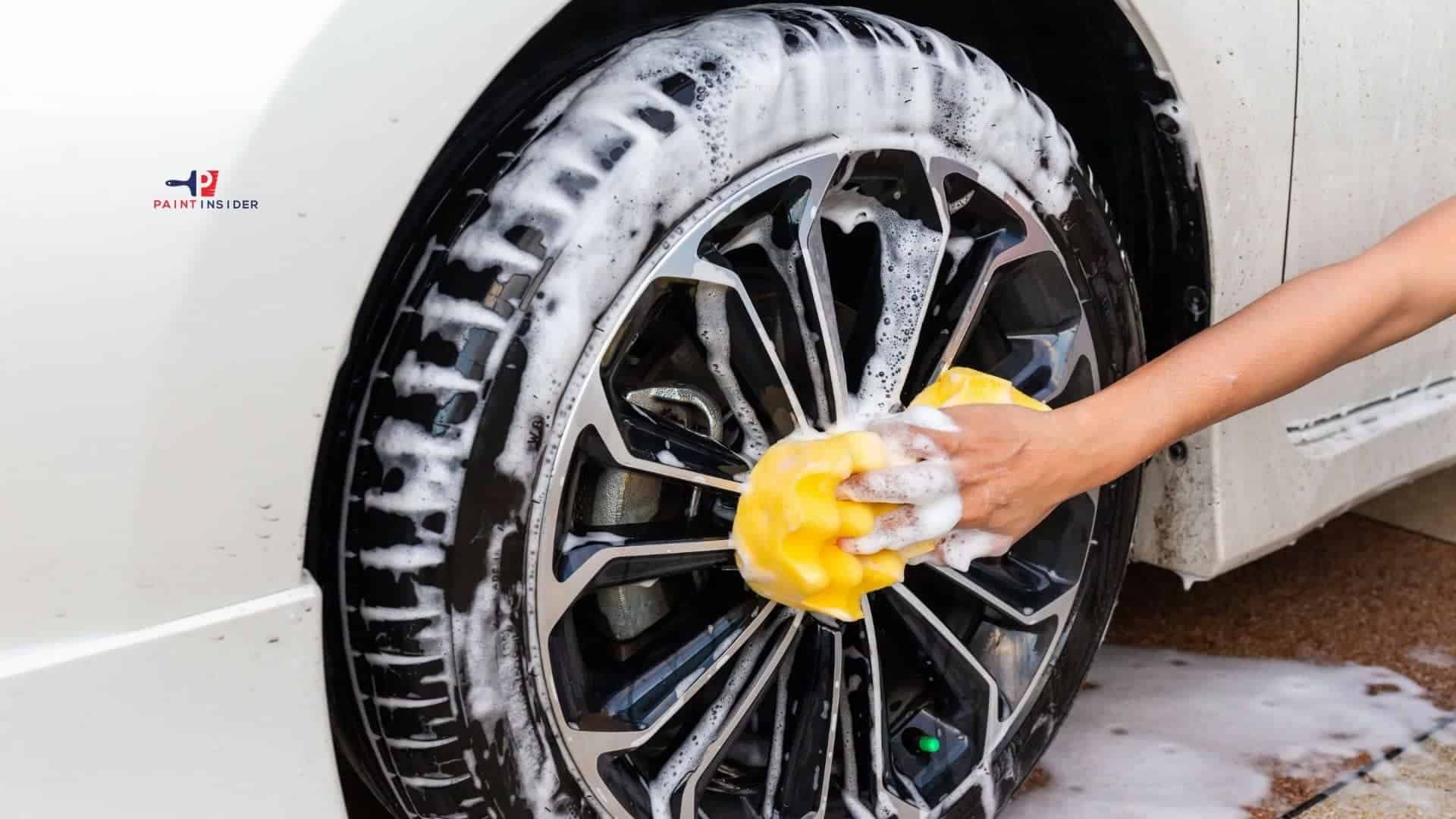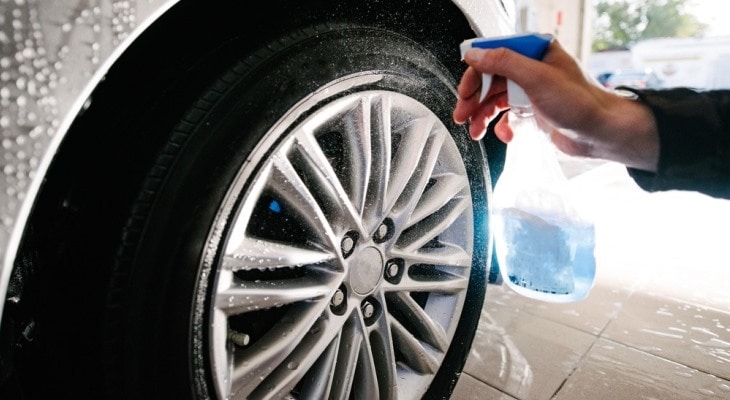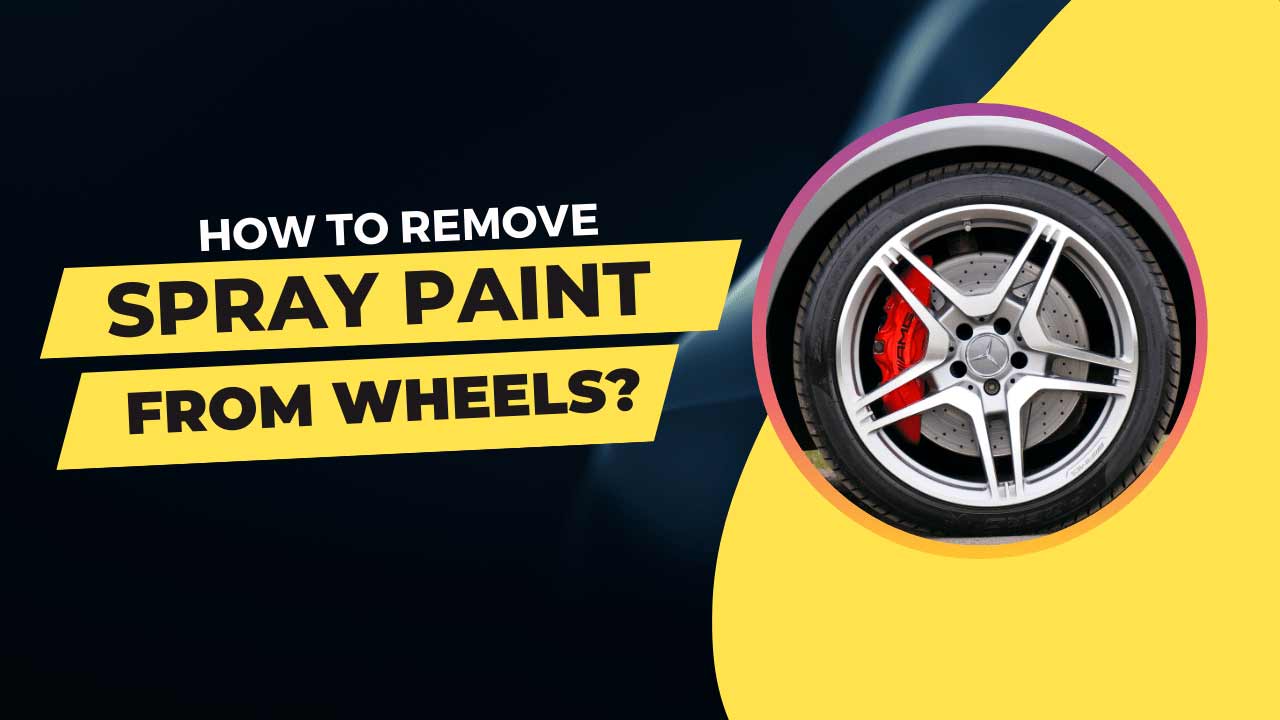How to get spray paint off wheels – Ever gone a little crazy with spray paint and accidentally coated your wheels? We’ve all been there! Whether you’re a seasoned DIYer or a first-time fixer-upper, removing spray paint from your wheels can be a challenge. But don’t fret, my friend! This guide is your ultimate solution, offering tips and tricks for removing that stubborn paint and leaving your wheels looking fresh and ready to roll.
From understanding the different types of spray paint to exploring the most effective removal methods, this guide covers everything you need to know. We’ll dive into chemical removers, abrasive cleaners, and even heat methods, comparing their pros and cons to help you choose the right approach for your situation. We’ll also provide step-by-step instructions and essential safety tips to ensure a smooth and successful paint removal process.
So, grab your tools and let’s get started!
Understanding Spray Paint Removal

Removing spray paint from wheels can be a challenging task, but with the right knowledge and approach, it can be done effectively. The success of the removal process depends on various factors, including the type of spray paint used, its age, and the material of the wheel.
Types of Spray Paint Used on Wheels
The type of spray paint used on wheels can significantly impact the removal process. Here are some common types of spray paint used on wheels:
- Acrylic Spray Paint: This is a common type of spray paint that is water-based and often used for decorative purposes. It is generally easier to remove than other types of paint.
- Enamel Spray Paint: Enamel spray paint is oil-based and known for its durability. It is often used for automotive applications, including wheels. Enamel spray paint can be more challenging to remove than acrylic paint.
- Specialty Spray Paint: Specialty spray paints, such as those designed for high-temperature applications, are formulated for specific purposes and may require specialized removal methods.
Factors Affecting Spray Paint Removal
Several factors can influence the effectiveness of spray paint removal, including:
- Paint Type: As mentioned earlier, different types of spray paint have varying degrees of adhesion and durability, making some easier to remove than others.
- Paint Age: Older paint tends to be more difficult to remove as it has had more time to cure and bond to the surface.
- Wheel Material: The material of the wheel can also affect the removal process. For example, removing spray paint from aluminum wheels may require different techniques than removing paint from steel wheels.
Identifying the Type of Spray Paint
Identifying the type of spray paint used on your wheels can help you determine the best removal method. Here are some tips for identifying the type of spray paint:
- Examine the Paint: If the paint is water-based, it will likely be more flexible and may even feel slightly sticky to the touch. Oil-based paint, on the other hand, will be harder and more durable.
- Check the Paint Can: If you still have the original paint can, the label will usually indicate the type of paint. However, this may not always be the case, especially if the paint was applied by a previous owner.
- Test a Small Area: Before attempting to remove the paint from the entire wheel, test a small, inconspicuous area with a solvent or paint remover. This will give you an idea of how the paint will react and whether the chosen method is effective.
Safe and Effective Methods

Removing spray paint from wheels can be challenging, but with the right approach, it can be done safely and effectively. The key is to choose the method that best suits the type of paint, the material of the wheels, and the level of effort you are willing to put in.
Chemical Removers
Chemical removers are the most effective way to remove spray paint from wheels, especially for stubborn or thick coats. They work by breaking down the chemical bonds of the paint, making it easier to remove.
- Pros: Chemical removers are generally fast-acting and effective, especially on tough paint.
- Cons: They can be harsh on some materials and require careful handling to avoid damage. Some removers may release harmful fumes, so proper ventilation is crucial.
Abrasive Cleaners
Abrasive cleaners are good for removing light coatings of spray paint, but they are not as effective as chemical removers for stubborn paint. They work by physically scrubbing away the paint using a rough material.
- Pros: Abrasive cleaners are relatively safe for most materials and can be used without the need for ventilation.
- Cons: They can be time-consuming and may leave scratches on the surface of the wheels.
Heat Methods
Heat methods work by softening the paint, making it easier to remove. This can be done using a heat gun or a hairdryer.
- Pros: Heat methods are generally safe and can be effective for removing paint from delicate surfaces.
- Cons: They can be time-consuming and require careful handling to avoid damaging the wheels.
Comparison Table
| Method | Pros | Cons |
|---|---|---|
| Chemical Removers | Fast-acting, effective on tough paint | Harsh on some materials, can release harmful fumes |
| Abrasive Cleaners | Safe for most materials, no ventilation required | Time-consuming, may leave scratches |
| Heat Methods | Safe for delicate surfaces | Time-consuming, requires careful handling |
Step-by-Step Guides
This section provides detailed step-by-step guides for removing spray paint from wheels using various methods. Each method has its own advantages and disadvantages, so choose the one that best suits your needs and the severity of the paint removal.
Using Chemical Removers
Chemical removers are effective for removing spray paint, especially when dealing with stubborn paint. However, it’s important to follow safety precautions and use appropriate personal protective equipment. Here’s a step-by-step guide for using chemical removers:
- Prepare the work area: Find a well-ventilated area and cover the surrounding surfaces to prevent damage from spills or overspray. Wear gloves, eye protection, and a respirator to protect yourself from harmful fumes.
- Apply the remover: Choose a chemical remover specifically designed for removing spray paint. Apply the remover generously to the affected area using a brush, cloth, or sponge. Ensure the remover completely covers the paint.
- Let it sit: Allow the remover to sit on the paint for the time specified on the product label. This allows the remover to penetrate the paint and loosen its bond to the wheel.
- Remove the paint: After the recommended dwell time, use a scraper or putty knife to gently remove the softened paint. Be careful not to scratch or damage the wheel surface.
- Clean the surface: Once the paint is removed, clean the surface thoroughly with soap and water to remove any remaining remover and paint residue.
- Dry the surface: Dry the wheel completely using a clean cloth or towel. Allow the wheel to air dry completely before applying any sealant or protective coating.
Using Abrasive Cleaners, How to get spray paint off wheels
Abrasive cleaners are effective for removing spray paint, especially when dealing with light paint coatings. However, it’s important to use these cleaners cautiously to avoid damaging the wheel surface. Here’s a step-by-step guide for using abrasive cleaners:
- Prepare the work area: Find a well-ventilated area and cover the surrounding surfaces to prevent damage from spills or overspray. Wear gloves and eye protection to protect yourself from any potential irritants.
- Choose an abrasive cleaner: Select an abrasive cleaner specifically designed for removing spray paint. Choose a cleaner with a fine grit to avoid scratching the wheel surface.
- Apply the cleaner: Apply the abrasive cleaner to a damp cloth or sponge. Gently rub the cleaner onto the affected area in a circular motion. Avoid excessive pressure to prevent damaging the wheel surface.
- Rinse and repeat: Rinse the area with water and inspect the paint removal. Repeat steps 3 and 4 until the paint is completely removed.
- Dry the surface: Dry the wheel completely using a clean cloth or towel. Allow the wheel to air dry completely before applying any sealant or protective coating.
Using Heat Methods
Heat methods can be effective for removing spray paint, especially when dealing with thick layers of paint. However, it’s important to use these methods cautiously to avoid damaging the wheel surface. Here’s a step-by-step guide for using heat methods:
- Prepare the work area: Find a well-ventilated area and cover the surrounding surfaces to prevent damage from spills or overspray. Wear gloves and eye protection to protect yourself from potential burns.
- Choose a heat source: Select a heat source appropriate for removing spray paint, such as a heat gun or hairdryer. Avoid using an open flame as it can damage the wheel surface.
- Apply heat: Direct the heat source towards the affected area, moving it continuously to avoid overheating any one spot. The heat should be enough to soften the paint without damaging the wheel surface.
- Remove the paint: Once the paint is softened, use a scraper or putty knife to gently remove the paint. Be careful not to scratch or damage the wheel surface.
- Clean the surface: Once the paint is removed, clean the surface thoroughly with soap and water to remove any remaining paint residue. Allow the wheel to air dry completely before applying any sealant or protective coating.
Essential Tools and Materials: How To Get Spray Paint Off Wheels
Before embarking on the journey of spray paint removal, it is imperative to equip yourself with the appropriate tools and materials. This will ensure a smooth and effective process while safeguarding your safety.
Chemical Removers
Chemical removers play a pivotal role in dissolving the paint’s adhesive properties. The choice of remover depends on the type of paint and the material of the wheels.
- Acetone: Acetone is a readily available solvent effective for removing acrylic and enamel paints. It is typically used for smaller paint spills and works well on metal surfaces.
- Lacquer Thinner: Lacquer thinner is a stronger solvent suitable for removing lacquer-based paints. It is commonly used for automotive applications and can be found at most hardware stores.
- Paint Stripper: Paint strippers are chemical solutions designed to remove multiple layers of paint. They are generally more potent than acetone or lacquer thinner and may require additional safety precautions.
Note: Always test the remover on a small, inconspicuous area of the wheel before applying it to the entire surface.
Abrasive Cleaners
Abrasive cleaners are used to physically remove the paint from the surface. They are often used in conjunction with chemical removers for a more thorough cleaning.
- Steel Wool: Steel wool is a versatile abrasive that can be used for removing light paint spills. It is available in various grades, with finer grades being gentler on the surface.
- Sandpaper: Sandpaper is a common abrasive used for removing paint from various surfaces. The grit of the sandpaper determines its abrasiveness, with higher grits being finer. For removing spray paint from wheels, it is recommended to use sandpaper with a grit of 220 or higher.
- Wire Brush: A wire brush is a sturdy abrasive tool suitable for removing heavy paint buildup. It is often used on metal surfaces and can be powered by a drill for faster removal.
Other Essential Tools
In addition to chemical removers and abrasive cleaners, you will need the following tools:
- Gloves: Gloves protect your hands from the chemicals and abrasives used in the paint removal process.
- Eye Protection: Eye protection is essential to prevent chemical splashes or abrasive particles from entering your eyes.
- Respirator: A respirator is recommended when working with strong chemicals to prevent inhalation of harmful fumes.
- Rag or Cloth: A clean rag or cloth is used for applying the remover, wiping away the paint, and drying the surface.
- Bucket: A bucket is used for mixing the remover and holding water for rinsing.
- Plastic Drop Cloth: A plastic drop cloth protects the surrounding area from paint spills and chemical drips.
Safety Precautions: Always wear gloves, eye protection, and a respirator when working with chemical removers. Work in a well-ventilated area and avoid contact with skin or eyes. Keep chemicals out of reach of children and pets.
Tips and Tricks
Removing spray paint from wheels can be a delicate process, requiring careful attention to avoid damaging the wheel surface. This section offers valuable tips and tricks to ensure a successful and professional outcome.
Protecting the Wheel Surface
Safeguarding the wheel surface is crucial during spray paint removal. This involves employing techniques that minimize the risk of scratches, gouges, or other damage. The following tips can help prevent damage to the wheel surface:
- Use a soft-bristled brush or sponge: Avoid using abrasive tools like steel wool or wire brushes, as these can scratch the wheel’s surface. Soft-bristled brushes and sponges are gentler and less likely to cause damage.
- Apply gentle pressure: Avoid excessive force when scrubbing or scraping the paint. Use light, circular motions to loosen the paint without damaging the underlying surface.
- Work in sections: Instead of tackling the entire wheel at once, focus on small sections to ensure thoroughness and minimize the risk of over-scrubbing.
- Use masking tape: If you are using a scraper or other sharp tools, mask off surrounding areas with masking tape to prevent accidental scratches.
- Regularly inspect the surface: Periodically check the wheel surface for any signs of damage, such as scratches or gouges. Stop immediately if you notice any damage and adjust your technique accordingly.
Achieving a Clean Finish
Achieving a clean and professional finish requires attention to detail and the right techniques. These tricks can help you achieve a flawless result:
- Use a good quality paint remover: Choose a paint remover specifically designed for automotive use and follow the manufacturer’s instructions carefully. This ensures effectiveness and minimizes the risk of damage to the wheel.
- Work in a well-ventilated area: Paint removers often contain strong chemicals that can be harmful if inhaled. Ensure adequate ventilation to prevent potential health risks.
- Rinse thoroughly: After using a paint remover, rinse the wheel thoroughly with water to remove any residue. This helps prevent any lingering chemicals from damaging the surface.
- Use a microfiber cloth: After cleaning, use a microfiber cloth to dry the wheel thoroughly. This helps prevent water spots and ensures a smooth finish.
- Consider professional help: If you are unsure about the process or have a particularly stubborn paint job, consider seeking professional help from a detailer or auto body shop.
Common Mistakes to Avoid
While removing spray paint from wheels, certain mistakes can lead to unsatisfactory results or damage to the wheel. Here are some common mistakes to avoid:
- Using harsh chemicals: Avoid using harsh chemicals that can damage the wheel’s finish. Stick to automotive-grade paint removers and follow the manufacturer’s instructions.
- Over-scrubbing: Excessive scrubbing can damage the wheel’s surface. Use gentle pressure and work in small sections to avoid unnecessary wear and tear.
- Ignoring safety precautions: Always wear appropriate safety gear, such as gloves and eye protection, when working with paint removers. This protects you from potential chemical exposure.
- Leaving residue: Thoroughly rinse the wheel after using a paint remover to remove any residue. This prevents lingering chemicals from damaging the surface.
- Skipping the drying step: Always dry the wheel thoroughly after cleaning to prevent water spots and ensure a smooth finish.
Alternative Solutions

When traditional methods for removing spray paint from wheels fail or seem too daunting, exploring alternative solutions is a wise move. These options range from professional cleaning services to DIY hacks, each with its own advantages and drawbacks.
Professional Cleaning Services
Professional cleaning services offer a convenient and potentially more effective approach to removing stubborn spray paint from wheels. These services typically employ specialized equipment and techniques, providing a high-quality finish.
- Effectiveness: Professional cleaners often use powerful solvents and equipment, achieving excellent results, especially for deeply embedded paint.
- Cost: Professional cleaning services can be expensive, especially if multiple wheels require attention.
- Convenience: Professional services save time and effort, handling the entire process from start to finish.
- Expertise: Professional cleaners have the experience and knowledge to tackle even the most challenging spray paint removal situations.
DIY Solutions
For those seeking cost-effective and accessible solutions, DIY options offer a range of approaches.
- Effectiveness: DIY solutions can be effective, especially for light to moderate spray paint application, but may require multiple applications.
- Cost: DIY solutions are generally more affordable than professional services, using readily available materials.
- Time Commitment: DIY methods can be time-consuming, requiring multiple steps and patience.
- Risk of Damage: Using harsh chemicals or improper techniques can potentially damage the wheel’s finish.
Removing spray paint from your wheels doesn’t have to be a stressful endeavor. With the right tools, techniques, and a little patience, you can achieve a clean and professional finish. Remember to prioritize safety, choose the most effective method for your specific situation, and enjoy the satisfaction of restoring your wheels to their former glory. Now, get out there and roll on, my friend!
Answers to Common Questions
What if the spray paint is really old and stubborn?
For older, hardened spray paint, you might need to use a stronger chemical remover or combine methods like soaking with a remover followed by gentle abrasion. Patience is key!
Can I use a wire brush to remove spray paint?
While wire brushes can be effective, they can also damage the wheel surface. Use them cautiously and only if necessary. Consider using a softer brush or abrasive cleaner first.
What should I do if I accidentally damage the wheel surface during removal?
If you scratch or damage the wheel, you can use a touch-up pen or paint to repair the affected area. For more significant damage, consider professional refinishing.